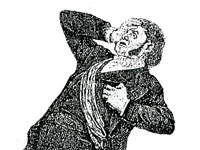First Person: Face to face with the tsunami
In Sri Lanka the day after Christmas, what we saw on our way to the beach
January 5, 2005
On holiday from Hong Kong, my family and I had just celebrated Christmas in Colombo, Sri Lanka. The next morning we were met by local friends who had offered to take us to the tropical beaches at the island’s southern tip. The day’s bright, sunny skies were typical of Sri Lanka’s “winter.” We were happily anticipating two days of relaxation and water activities at the Unawatuna Beach Resort, just past Galle on the narrow two-lane coastal road.
Altogether 10 of us piled into both a hired van and a private car. Once out of Colombo we glimpsed the ocean and commented on the fishing villages comprised of closely packed and flimsily constructed wooden shacks.
We wondered aloud what would happen in the event of a typhoon or other severe weather, but were assured by our host that nothing like that ever happened in Sri Lanka.
Halfway to our destination, we drove through Beruwala where suddenly people were streaming towards us from the dirt roads and paths that led from their seaside villages to our right. Many were crying and screaming, obviously very frightened. We thought there had been a car bombing.
We learned later they what they were shouting: “The sea is coming into the land!”
As water mixed with debris began flowing slowly under our car, we had to turn around. By now the faces of fear and panic were on both sides of our car. Mothers and fathers scurried beside us holding their small children or assisting an elderly parent. At one point I saw a man running alongside the road being hit in the shoulder with the side view mirror of a passing truck.
When the chaos caused traffic to stop, a large group of Sri Lankans approached the side of the van demanding a ride. As I watched, I worried for the safety of my wife and children inside. At first, the driver, Pala, refused to let them in — the nine-passenger van already had seven — but then they began pounding on the sides and windows.
I asked our daughter, Julia, to describe the scene inside: “Fifteen men, women and children, including three babies, squished into our van and we all moved over so that my brother, Chas, was sitting on my sister, Natalie, and I had all the luggage on my lap. Mom was in the front passenger seat. One girl was cut on her side. Another child’s hand was bleeding. The children were crying and the women were wailing. At first we were in shock as we looked into the panic-stricken eyes of these families. But Natalie began to console one of the girls sitting next to us who was crying and we all followed her lead by smiling at the babies, holding the hands of the girls and stroking their backs. The entire car soon settled down, and it was more or less quiet for the rest of the car ride except for the four kids who got sick and threw up out the window and in the van.”
Parts of their conversations were later translated to me by our friend, Naqeeb: My son is missing … My mother is missing … Our neighbor is dead … My friend is missing … My money and my house are gone.
After two hours, the evacuees were dropped off at their destination near a relative. We continued on to the Mount Lavinia Hotel, safely situated on a bluff above the ocean, where we could regroup. It was there that we first heard on the radio news the word that has become all-too familiar: tsunami.
From an overhanging balcony by the hotel’s pool, we could see the beach stretching up to Colombo. We watched the last of the tidal waves as they rose and fell back, subsiding with less and less force. While we witnessed a man being rescued 20 meters off shore, tables, chairs and other household items floated by, stolen by the ocean’s current.
Meanwhile at poolside, sunbathers, seemingly oblivious, were applying suntan lotion. As we stepped up to a sumptuous luncheon buffet, “Strangers In The Night” was accompanying the surreal scene before us. And the band played on.
By late afternoon we were safely back at the hotel in Colombo, overwhelmed by the day’s events. I called room service and remained glued to the BBC, CNN and local Sri Lankan stations. The tour desk informed us that the Unawatuna Beach Resort, where we were going to spend the day and night, had been swept away and that some of the guests and staff were still missing.
Awakening the next morning to the news of the ever-rising number of casualties, we went to the Red Cross where we were provided a list of medical supplies that would be needed over the next 24 hours. My son, Chas, and I and three locals cleaned out two pharmacies of their stock of antibiotics and painkillers and we had the satisfaction of knowing our donation was included in a truckload headed south that same evening.
Meanwhile Franny, Natalie, Julia and my mother set up a “Tsunami Victims Help Desk” in the hotel lobby. They listened to the tragic and heroic accounts of some of the 300 survivors who had been evacuated from the beachside resorts and were now being put up on mattresses in the hotel’s conference rooms. They collected over 100,000 rupees ($1,000) in cash that day, plus every imaginable kind of medicine that hotel guests picked out of their travel kits to give to the Red Cross. Our “Help Desk” became a model for six or seven other hotels nearby.
Though feeling guilty, we went on a pre-planned tour of Kandy’s famous botanical gardens and the lush mountainous areas of Sri Lanka, including endless tea fields on steep-sloping terrain. Coming back through the Colombo hotel’s main doors two days later, the lobby lounge was even more crowded with tourists whose resort rooms had been demolished. Some were in the bathing suits they were wearing when the tsunami hit.
One survivor we met was Alex. He had been separated from his girlfriend when their romantic beach bungalow was destroyed. With casts on both legs, he was taking a flight back to Britain the next day. His girlfriend’s decomposed body had been located the day before. We met her father who had flown over to assist Alex and had the unthinkable task of identifying his daughter’s body and returning her home.
Our last day in Sri Lanka, we went to a collection site for donations and helped form bucket brigades to load and unload trucks filled with water bottles, used clothing and medicine. We were rewarded by drinking the delicious milk from freshly cut king coconuts.
We departed Sri Lanka for Hong Kong on New Year’s Day as the world’s largest, most logistically complicated peacetime relief effort was getting under way. When we emerged from the Kowloon tunnel in our airport limousine, Hong Kong’s glamorous skyscrapers stood in contrast to the devastated structures of the poor fishing villages we had just left behind.
As witnesses to the effects of one of the deadliest natural disasters in history, we all feel we have been through a life-changing experience.
From televised images we have seen the devastating power of nature. We have seen firsthand the faces of fear and the chaos resulting from panic. We have learned that even as mere individuals we can play a part in a larger effort to help bring relief to those whose lives go on.
And we now have a greater appreciation for the value of our lives and pray for those families who have suffered through this catastrophe.
Re-printed with permission from the Pittsburgh Post-Gazette


